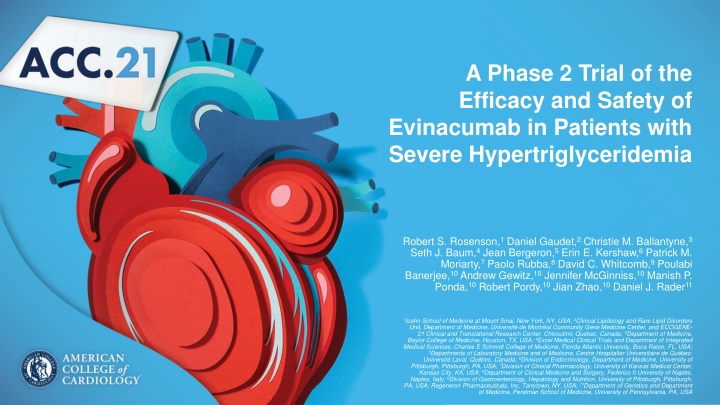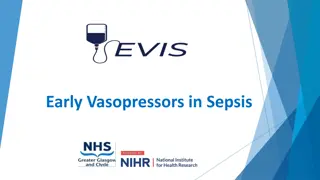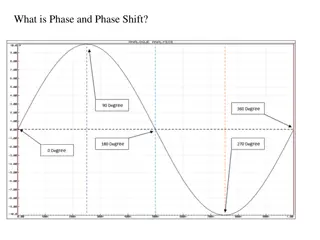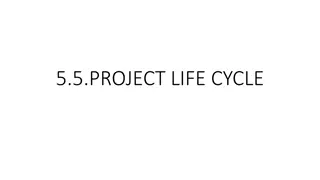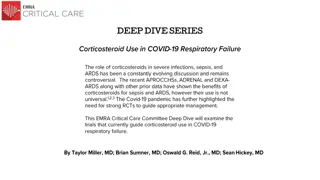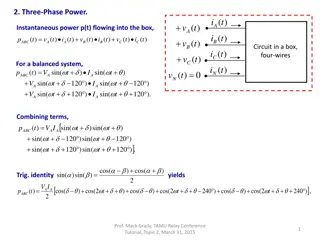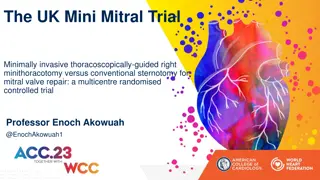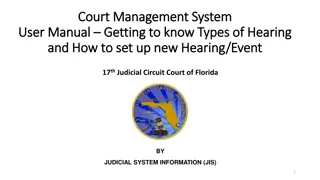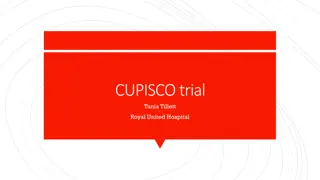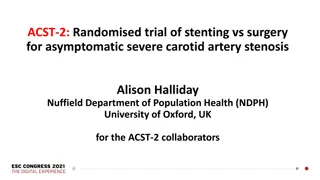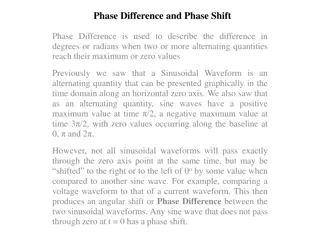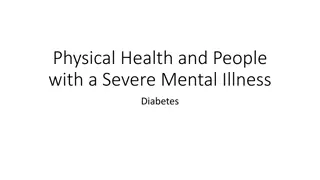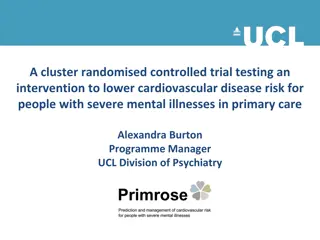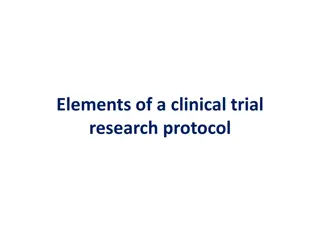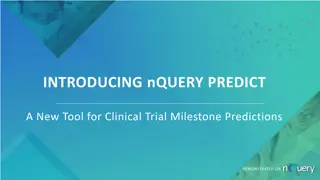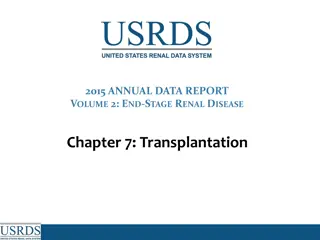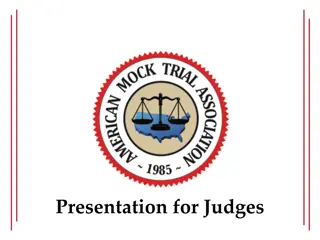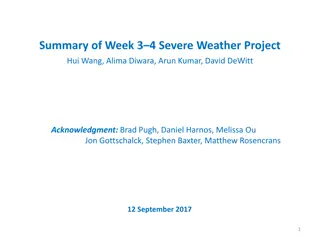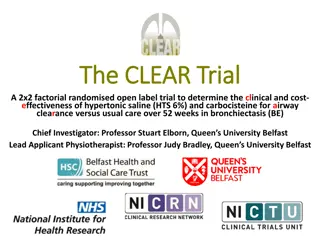Phase 2 Trial of Evinacumab in Patients with Severe Hypertriglyceridemia
A Phase 2 trial assessed the efficacy and safety of evinacumab in patients with severe hypertriglyceridemia at risk of acute pancreatitis. The study focused on ANGPTL3 variants and their impact on lipid metabolism, proposing evinacumab as a potential therapeutic option.
Download Presentation

Please find below an Image/Link to download the presentation.
The content on the website is provided AS IS for your information and personal use only. It may not be sold, licensed, or shared on other websites without obtaining consent from the author.If you encounter any issues during the download, it is possible that the publisher has removed the file from their server.
You are allowed to download the files provided on this website for personal or commercial use, subject to the condition that they are used lawfully. All files are the property of their respective owners.
The content on the website is provided AS IS for your information and personal use only. It may not be sold, licensed, or shared on other websites without obtaining consent from the author.
E N D
Presentation Transcript
A Phase 2 Trial of the Efficacy and Safety of Evinacumab in Patients with Severe Hypertriglyceridemia Robert S. Rosenson,1 Daniel Gaudet,2 Christie M. Ballantyne,3 Seth J. Baum,4 Jean Bergeron,5 Erin E. Kershaw,6 Patrick M. Moriarty,7 Paolo Rubba,8 David C. Whitcomb,9 Poulabi Banerjee,10 Andrew Gewitz,10 Jennifer McGinniss,10 Manish P. Ponda,10 Robert Pordy,10 Jian Zhao,10 Daniel J. Rader11 1Icahn School of Medicine at Mount Sinai, New York, NY, USA; 2Clinical Lipidology and Rare Lipid Disorders Unit, Department of Medicine, Universit de Montr al Community Gene Medicine Center, and ECOGENE- 21 Clinical and Translational Research Center, Chicoutimi, Quebec, Canada; 3Department of Medicine, Baylor College of Medicine, Houston, TX, USA; 4Excel Medical Clinical Trials and Department of Integrated Medical Sciences, Charles E Schmidt College of Medicine, Florida Atlantic University, Boca Raton, FL, USA; 5Departments of Laboratory Medicine and of Medicine, Centre Hospitalier Universitaire de Qu bec- Universit Laval, Qu bec, Canada; 6Division of Endocrinology, Department of Medicine, University of Pittsburgh, Pittsburgh, PA, USA; 7Division of Clinical Pharmacology, University of Kansas Medical Center, Kansas City, KA, USA; 8Department of Clinical Medicine and Surgery, Federico II University of Naples, Naples, Italy; 9Division of Gastroenterology, Hepatology and Nutrition, University of Pittsburgh, Pittsburgh, PA, USA; Regeneron Pharmaceuticals, Inc, Tarrytown, NY, USA; 11Department of Genetics and Department of Medicine, Perelman School of Medicine, University of Pennsylvania, PA, USA
Background 50 46.67 45.16 sHTG, defined as fasting TGs 500 mg/dL, is a causal risk factor for AP1 45 41.67 40 35 Incidence rate, % 29.85 28.57 30 Patients with sHTG-related AP often have recurrent attacks requiring repeat hospital admissions, with worse outcomes than those with non-hypertriglyceridemia- related AP 23.48 25 22.48 20 15 11.19 8.48 10 6.67 5 0.93 0.81 0.21 0.1 0.07 0 No AP events in the past 12 months 1 AP event in the past 12 months <200 200 to 500 2 AP events in the past 12 months >880 >1000 Proximate TG (mg/dL): 500 to 880 AP, acute pancreatitis; sHTG, severe hypertriglyceridemia; TG, triglyceride.
Background ANGPTL3, an important regulator of lipid metabolism, acts by inhibiting lipoprotein lipase and endothelial lipase3-5 Individuals with LOF variants in ANGPTL3 have demonstrated significantly reduced TGs and other atherogenic lipoproteins6,7 Evinacumab, a fully human monoclonal antibody ANGPTL3 inhibitor, may be a potential therapeutic option for patients with sHTG4,6-8 In this Phase 2 study (NCT03452228), we evaluated the efficacy and safety of evinacumab in patients with sHTG who had 1 prior hospitalization for AP ANGPTL3, angiopoietin-like 3; AP, acute pancreatitis; LOF, loss of function; TG, triglyceride.
Methods In this double-blind, placebo-controlled, Phase 2 trial, 51 patients were treated and assigned to one of three cohorts based on genotype according to the presence of LOF mutations in LPL pathway genes Actual Cohort Mutation Patients with FCS 1 (with bi-allelic LOF mutations in APOA5, APOC2, GPIHBP1, LMF1, or LPL) (n=17) Aged 18 75 years Presence of sHTG Patients with MCS (with known heterozygous LOF mutations in APOA5, APOC2, GPIHBP1, LMF1, or LPL) 2 History of hospitalization for AP (n=15) Patients were initially enrolled into their cohorts based on medical history at screening; however, they were subsequently genotyped by the Regeneron Genetics Center and reclassified into their actual cohort for the purpose of analysis Patients with MCS and without LPL pathway mutations 3 (n=19) Fasting serum TGs 500 mg/dL at screening on two separate occasions; medical history of fasting TGs 1000 mg/dL AP, acute pancreatitis; FCS, familial chylomicronemia syndrome; LOF, loss of function; LPL, lipoprotein lipase; MCS, multifactorial chylomicronemia syndrome; sHTG, severe hypertriglyceridemia
Methods DBTP (12 weeks) SBTP (12 weeks) Safety follow-up period (20 weeks) N=35 Screening period (up to 37 days) Evinacumab 15 mg/kg Q4W x 3 Evinacumab 15 mg/kg Q4W x 3 Randomized 2:1 N=16 Evinacumab 15 mg/kg Q4W x 3 Placebo run-in (4 weeks) Placebo Q4W x 3 0 4 8 12 Evinacumab or placebo administered visits (weeks) The primary endpoint was to determine the intra-patient change in serum TGs from baseline following 12 weeks of intravenous evinacumab treatment in Cohort 3 patients* *Patients with MCS and without LPL pathway mutations DBTP, double-blind treatment period; Q4W, every 4 weeks; SBTP, single-blind treatment period; TG, triglyceride.
Results Patient demographics and baseline characteristics were generally well balanced Actual Cohort 1 Placebo IV Q4W (n=5) 43.2 (15.7) 4 (80.0) 4 (80.0) 26.6 (4.1) 5 (100) Actual Cohort 2 Placebo IV Q4W (n=6) 52.8 (13.5) 2 (33.3) 5 (83.3) 27.9 (5.6) 6 (100) Actual Cohort 3 Placebo IV Q4W (n=5) 41.2 (7.8) 3 (60.0) 3 (60.0) 30.0 (1.9) 5 (100) Evinacumab IV 15 mg/kg Q4W (n=12) 51.3 (9.4) 6 (50.0) 11 (91.7) 26.8 (5.2) 12 (100) Evinacumab IV 15 mg/kg Q4W (n=9) 48.7 (10.3) 6 (66.7) 7 (77.8) 31.5 (4.3) 9 (100) Evinacumab IV 15 mg/kg Q4W (n=14) 46.1 (11.0) 6 (42.9) 11 (78.6) 28.9 (5.0) 14 (100) Age, years, mean (SD) Male, n (%) White, n (%) BMI, kg/m2, mean (SD) History of AP, n (%) Time from the most recent occurrence of AP, years, mean (SD)* Concomitant LLT, n (%) Baseline fasting TGs, mg/dL, median (Q1:Q3) 5.5 (7.8) 8.5 (9.6) 1.9 (1.1) 3.9 (3.8) 1.8 (1.6) 3.0 (4.6) 3 (60.0) 3918 (3122:3931) 6 (50.0) 3141 (2713:3921) 6 (100) 1352 (769:4010) 9 (100) 1238 (1020:2341) 4 (80.0) 1031 (1022:1496) 10 (71.4) 1917 (1196:2607) *Time from diagnosis to study randomization. Cohort 1, patients with FCS (with bi-allelic LOF mutations in APOA5, APOC2, GPIHBP1, LMF1, or LPL); cohort 2, patients with MCS (with known heterozygous LOF mutations in APOA5, APOC2, GPIHBP1, LMF1, or LPL) ; cohort 3, patients with MCS and without LPL pathway mutations AP, acute pancreatitis; BMI, body mass index; IV, intravenous; LLT, lipid-lowering therapy; Q4W, every 4 weeks; SD, standard deviation.
Results In cohort 3, the least squares mean (SE) reduction in TGs from baseline (pre-specified primary endpoint) was 27.1% (37.4%) 95% CI 71.2 to 84.6, and the corresponding median reduction in TGs was 68.8% (95% CI 84.1 to 38.8) (absolute median change in TG of 905 mg/dL from baseline), after 12 weeks of treatment (combination of DBTP and SBTP) Cohorts 2 and 3 showed clinically meaningful reductions in TGs during the DBTP. The TG-lowering effect persisted throughout the SBTP Overall, changes in lipid/lipoprotein parameters observed during the DBTP were maintained during the SBTP CI, confidence interval; DBTP, double-blind treatment period; SBTP, single-blind treatment period; SE, standard error; TG, triglyceride.
Results A. Actual Cohort 1 B. Actual Cohort 2 C. Actual Cohort 3 Actual Cohort 1 placebo IV Q4W Actual Cohort 1 evinacumab IV 15 mg/kg Q4W Actual Cohort 2 placebo IV Q4W Actual Cohort 2 evinacumab IV 15 mg/kg Q4W Actual Cohort 3 placebo IV Q4W Actual Cohort 3 evinacumab IV 15 mg/kg Q4W P-value 0.0418 P-value 0.0076 P-value 0.9495 140 120 100 80 60 40 20 Median (Q1-Q3) change in TG from baseline, % 0 20 40 60 80 100 Baseline 2 4 6 Baseline 2 4 6 Baseline 2 4 6 8 12 8 12 8 12 Week Week Week Number of patients 6 6 6 6 6 6 4 5 5 5 5 4 4 Placebo IV Q4W 5 5 3 4 4 Evinacumab IV 15 mg/kg Q4W 9 9 9 12 1 1 1 1 1 1 1 1 1 1 9 9 9 14 1 1 12 1 1 12 12 IV, intravenous; Q4W, every 4 weeks; TG, triglyceride.
Results Apo CIII Apo B48 Apo CIII Apo B48 Apo CIII Apo B48 Non-HDL-C Non-HDL-C Non-HDL-C 147.9 300 Percent change from baseline, mean (95% CI) 95.3 250 200 150 35.3 28.2 47.1 100 30.7 25.6 1.6 50 0 -50 -10.3 -40.7 -33.7 -18.1 -24.1 -17.6 -33.6 -100 -54.9 -150 -22 -34.5 -200 Cohort 1 Cohort 2 Cohort 3 Evinacumab Placebo Substantial reductions in non-HDL-C, Apo CIII, Apo B48 were also observed from baseline to week 12 Apo, apolipoprotein; CI, confidence interval; non-HDL-C, non-high-density lipoprotein cholesterol.
Results TEAEs occurred in a similar proportion of patients in the evinacumab and placebo groups during the SBTP, inclusive of the 20-week off-drug period Five AP events were reported by five patients during the DBTP (8.6% evinacumab group [n=3/35]; 12.5% placebo group [n=2/16]) During the 12-week SBTP active treatment period, seven AP events were reported in five patients Most AP events occurred in the off-drug period >4 weeks after the last evinacumab dose, when TGs had increased towards pre-treatment levels and evinacumab concentrations had decreased to sub-therapeutic levels AP, acute pancreatitis; DBTP, double-blind treatment period; IV, intravenous; Q4W, every 4 weeks; SBTP, single blind treatment period; TEAE, treatment-emergent adverse event; TG, triglyceride.
Results Evinacumab 15 mg/kg IV Q4W (N=35) 25 (71.4) 4 (11.4) 2 (5.7) 0 Placebo IV Q4W (N=16) TEAEs in >5% of patients* N (%) of patients Patients with at least one TEAE Patients with at least one serious TEAE Patients with at least one TEAE resulting in discontinuation of treatment Patients with at any TEAE resulting in death TEAEs occurring in 2 patients in any group Abdominal pain Headache Constipation Acute pancreatitis Abdominal discomfort Alanine aminotransferase increased Aspartate aminotransferase increased Back pain Contusion Dizziness Herpes zoster Nasopharyngitis Sinusitis Type 2 diabetes mellitus 11 (68.8) 3 (18.8) 0 0 2 (12.5) 1 (6.3) 0 2 (12.5) 0 0 0 0 0 0 0 1 (6.3) 0 1 (6.3) 5 (14.3) 4 (11.4) 3 (8.6) 3 (8.6) 2 (5.7) 2 (5.7) 2 (5.7) 2 (5.7) 2 (5.7) 2 (5.7) 2 (5.7) 2 (5.7) 2 (5.7) 2 (5.7) *Occurring during the DBTP. AP, acute pancreatitis; DBTP, double-blind treatment period; IV, intravenous; Q4W, every 4 weeks; SBTP, single blind treatment period; TEAE, treatment-emergent adverse event; TG, triglyceride.
Conclusions In patients with sHTG, but without genetic FCS, evinacumab substantially reduced fasting TG levels; however, the treatment response was highly variable and dependent on genotype Data from this study supports further assessment of the effects of evinacumab in patients with sHTG, especially those with a history of sHTG-associated AP A Phase 2b trial will investigate the efficacy of TG lowering with evinacumab on the prevention of AP (NCT04863014) AP, acute pancreatitis; sHTG, severe hypertriglyceridemia; TG, triglyceride.
Disclosures RSR reports grants and/or personal fees from Regeneron Pharmaceuticals, Inc., Amgen, The Medicines Company, Novartis, CVS Caremark, Kowa, UpToDate, and 89Bio; and reports stock holdings in MediMergent, LLC DG reports grants and/or personal fees from Akcea, Amryt Pharma, Arrowhead, Esperion, Gemphire, HDL Therapeutics, Novartis, Regeneron Pharmaceuticals, Inc., and Sanofi. CMB reports grants from Abbott Diagnostic, Akcea, Amarin, Amgen, Esperion, Ionis, Novartis, Regeneron Pharmaceuticals, Inc, Roche Diagnostic, and Sanofi-Synthelabo; and consultancy fees from Akcea, Amarin, Amgen, Arrowhead, Astra Zeneca, Boehringer Ingelheim, Denka Seiken, Esperion, Intercept, Janssen, Matinas BioPharma Inc, Merck, Novartis, Novo Nordisk, Regeneron Pharmaceuticals, Inc., and Sanofi-Synthelabo. SJB reports grants and/or personal fees from Akcea, Amgen, Boehringer Ingelheim, Eli Lilly, Novo Nordisk, Akcea, Amgen, Regeneron Pharmaceuticals, Inc., Sanofi, Novo Nordisk, Guidepoint Global, GLG Group, Akcea, Amgen, and Esperion. JB reports grants and/or personal fees from Akcea, Amgen, HLS Therapeutic, Inc., Kowa, Novartis, Regeneron Pharmaceuticals, Inc., and Sanofi. EEK reports grants and/or personal fees from Regeneron Pharmaceuticals, Inc. PMM reports consultancy/advisory board fees from Aegerion, Duke, Eliaz Therapeutics, Esperion, Gemphire Therapeutics, Kaneka, Kastle Therapeutics, RegenXBio, and Stage 2 Innovations; speaker fees from Amarin, Ambry Genetics, Amgen, Regeneron Pharmaceuticals, Inc., and Sanofi; and research funding from Akcea, Amgen, FH Foundation, Gemphire, Ionis, Kaneka, Kowa, Novartis, Pfizer, Regeneron Pharmaceuticals, Inc., Sanofi, Stage 2 Innovations, University of Pennsylvania, and Zydus Discovery. PR reports grants from Regeneron Pharmaceuticals, Inc. DCW has been a consultant to AbbVie, Abbott, Ariel Precision Medicine, BioNTech, Nestle, Novartis, Regeneron, Samsung, Takata, is a co-founder and of Ariel Precision Medicine and may have equity and reports personal fees as Section Editor, Pancreas for UpToDate and as Editor-in-Chief of Clinical and Transitional Gastroenterology. PB, MP, RP, and VS are employees and/or stockholders of Regeneron Pharmaceuticals, Inc. PB, MP, RP, and VS are employees and/or stockholders of Regeneron Pharmaceuticals, Inc. DJR reports consultancy fees/honoraria for scientific advisory board participation for Alnylam, Novartis, Pfizer, and Verve; has consulted for Regeneron Pharmaceuticals, Inc.; and has ownership interest/partnership/principal in Staten Bio and Vascular Strategies.
Funding This study was funded by Regeneron Pharmaceuticals, Inc.
References 1. Laufs U et al. Eur Heart J. 2020;41:99 109c. 2. Dron JS, Hegele RA. Front Endocrinol (Lausanne) 2020;11:455. 3. Musunuru Ket al.N Engl J Med. 2020;363:2220 2227. 4. Adam RCet al.J Lipid Res 2020;61:1271 1286. 5. Shaik A, Rosenson RS. Cardiovasc Drugs Ther. 2021. In press. 6. Dewey FEet al.N Engl J Med. 2017;377:211 221. 7. Stitziel NOet al.J Am Coll Cardiol. 2017;69:2054 2063. 8. Gaudet Det al.N Engl J Med. 2017;377:296 297.
